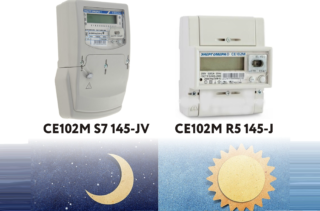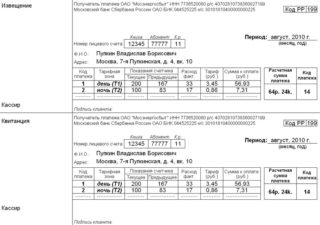Every year, the cost of utility bills is growing rapidly, which encourages people to look for ways to reduce these costs. Two-tariff electricity meters are becoming more and more popular, since they record the volume of consumed resources spent in the daytime and at night, and the cost of energy consumed varies depending on the time of day.
What is the principle of saving
Power consumption during the day is not uniform. In the morning, the load on electric networks is growing rapidly, during the day it reaches its peak, and in the evening it is declining. Such loads adversely affect the performance, power and availability of electrical communications. To prevent voltage subsidence and reduce the number of breakdowns, energy supply companies have developed a multi-tariff payment system. To implement such a system, special two-tariff electricity meters were required, in which the prices for the used volume of the resource depend on the time of consumption.
For example, if you turn on the dishwasher or washing machine after 23 hours, the cost of consumption will be lower, while the load on the network in the daytime will decrease.
The difference between day and night energy consumption
At night, light bulbs shine brighter than in the evening. You can verify this personally. This trend is most pronounced in places remotely located from a transformer substation, for example, in urban settlements or villages. In some cases, these differences are critical, therefore, it becomes necessary to purchase voltage stabilizers.
In the integrated energy systems designed to provide a resource for apartment buildings, it is enough to purchase and install advanced two-tariff metering devices.
The cost of each 1 kW consumed in the daytime by a two-tariff design has a higher cost in comparison with an ordinary meter. At night, the preferential tariff becomes active, which allows you to reduce the item of expenditure intended for payment of utilities.
The principle of electricity metering at night
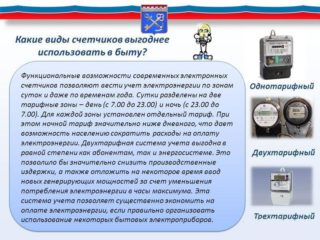 The manufacturer at the stage of manufacture of the electricity meter programs it for two time periods:
The manufacturer at the stage of manufacture of the electricity meter programs it for two time periods:
- Daytime - from 07:00 to 23:00.
- Night time - from 23:00 to 07:00.
In the daytime, standard tariffs that are valid in a particular region are active. The difference in the cost of the resource consumed in the evening and at night is significant in some areas, and not particularly in others.
To understand the principle of accounting and the difference, it is worth considering an example of previously relevant tariff plans in large cities.
| St. Petersburg | Moscow | |
| Daily rate | 2.49 rub / kW | 3.48 rub / kW |
| Night rate | 1,50 rub / kW | 0.88 rub / kW |
Thanks to this system, power engineers are able to effectively distribute the load on the network, and housing owners to reduce costs.
Device Options and Specifications
Manufacturers make many modifications of two-tariff electric meters. The more features they are equipped with, the higher the cost. The main task of each device is to conditionally divide the consumption metering by time and display all the data on the built-in display.
More advanced models can be remotely connected to a computer, from where information is supplied to the relevant organizations.
Some devices are equipped with memory cards, where all data on expenses is stored for a month. This is a very convenient feature that allows you to resolve contentious issues with service providers. There are other additional options:
- Monitoring the stability of voltage in the electrical network.
- Current control
- Display on the device panel of all data for monitoring power consumption in real time.
Despite the large assortment of two-tariff metering devices, the models from the manufacturer Mercury are in greatest demand.
Pros and cons of dual tariff meters
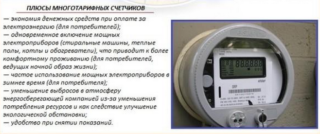 Innovative metering devices are rapidly gaining popularity due to a large number of advantages:
Innovative metering devices are rapidly gaining popularity due to a large number of advantages:
- The operation of such devices helps to improve the environmental situation. This is due to the fact that the amount of emissions from fuel combustion is reduced due to uneven load distribution.
- Saving the family budget. The acquisition and installation of a new meter will pay off in about a year of its correct use.
- Unloading electrical substations. Energy supplying companies will not often be forced to resort to repairs; the system will operate normally.
Most consumers are not interested in environmental friendliness of the use of appliances and streamlining supplies, so for residents the most significant advantage is the reduction in utility bills.
Disadvantages of dual tariff meters:
- In some regions of the country, the difference between day and night rates is minimal. For example, the price of 1 kW in the daytime is only 15% higher than at night. Savings can not be called tangible.
- It will be possible to reduce costs only with the correct use of household appliances.
To save, you need to make adjustments to the usual use of technology.
How to take readings
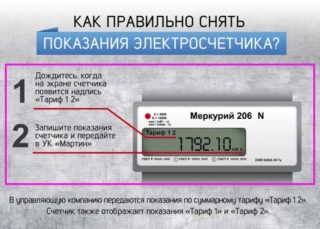 Electricity meters with two tariffs display data with high accuracy. All information in real time is displayed on the integrated display. Additionally, the display shows information about the degree of load on the electrical network, which allows to rationalize resource consumption.
Electricity meters with two tariffs display data with high accuracy. All information in real time is displayed on the integrated display. Additionally, the display shows information about the degree of load on the electrical network, which allows to rationalize resource consumption.
On the meter, a capital letter “T” is displayed with the digital marking 1, 2 and 3. Also, the meter is equipped with a special “Enter” button, designed to take readings at different rates.
The algorithm for taking readings from two-tariff electricity meters is as follows:
- On a sheet of paper, fix the numbers at the daily rate (labeled T1).
- By pressing the “Enter” button, display the readings at the night rate. Information is displayed under the T2 mark.
- Write even lower data that were received last month.
- Based on the new data received and the old, you can calculate the amount of resource consumed during the current month. For this, data from the previous month are deducted from the current readings.
- Based on the data received, calculate the cost. For this, each 1 kW of electricity consumed is multiplied by the cost of each tariff separately.
- The resulting amounts for the night and daily rates add up.
The numbers following the decimal point on the display do not need to be recorded. They complicate the calculation process and often cause errors.
How to fill out receipts for electricity
In most cases, consumers are forced to fill out receipts themselves, since energy supply companies do not track paperwork.
Algorithm for filling out receipts:
- You need to start by making bank details. Data can be found in the contract concluded between the consumer and the energy company.
- Next, you should write data about the consumer - payer: full name, address, as well as personal account number.
- Be sure to fix the time period for which payment is made.As a rule, people pay utility bills once a month.
- In the table, the first runoff is for entering data calculated according to the tariff T1. Information is entered not only for the current month, but also the past. Information on the tariff rate and the amount payable is also recorded.
- The next line is filled in the same way, only the data is entered according to the night tariff T2.
- The final stage - all data is summarized.
The form of the filled-in receipt must be approved by the energy supplying company. In some cases, it is additionally required to record the model of the meter. If the consumer has difficulty in correctly filling out receipts, you can get detailed advice in the post offices, where utility bills are paid. Most energy supply companies have their own website, where consulting free support is provided around the clock.
Two-tariff electricity meters are becoming more and more popular annually, as consumers find a profit in its installation. Taking readings and filling out receipts do not have difficulties, just get used to the main features.
